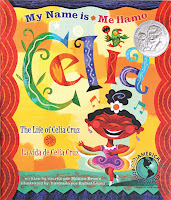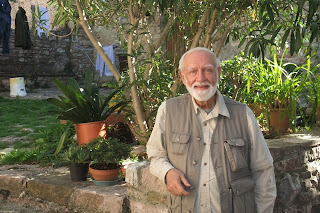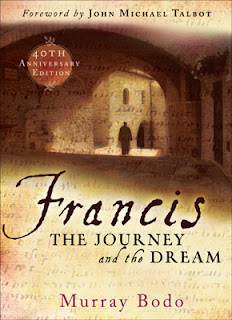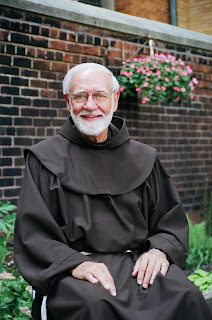I’ll begin by saying: I’ve had the pleasure of occasionally spending time with warm, energetic and talented Monica Brown. Congratulations on your eleven wonderful children’s books, Monica! Welcome to Bookjoy Creativity Salon!
1. You are an author, presenter, professor, friend and inspiration to many, and a family member. Wow! Do you enjoy your academic life?
MB: I do enjoy being a professor—for the decade before I started writing children’s books I had the pleasure of teaching and writing about the most amazing Latino/a literary works and introducing college students to new worlds of literature. I think the best preparation for writing is reading, so I had the best training of all. First, teaching, researching, and talking about Latino/a literature and then I began creating Latino/a literature for children, inspired by the birth of my two daughters, Isabella and Juliana. I wanted them to know who Gabriela Mistral was, who Celia Cruz was.
2. Is there a connection between that life and your work as an author for children? Has being a writer changed your teaching?
MB: The two are intimately connected, in mostly positive ways. For example, when I was researching my book on Gabriel Garcia Marquez, I decided to develop a new class—a comparative literature of the Americas. I taught a senior seminar that compared magical realist texts by U.S. Latino/a authors such as Luis Urrea’s The Hummingbird’s Daughter, Ana Castillo’s So Far from God, and Marie Arana’s Cellophane to South American novels such as Isabel Allende’s House of Spirits and Gabriel Garcia Marquez’s seminal One Hundred Years of Solitude, a book that changed the direction of my life. I first read One Hundred Years of Solitude when I was a senior in high school and it captured me as no other, perhaps before or since. This teaching and writing led me to the publication of my very own magic realist text for children, Chavela and the Magic Bubble.


3. Tell us briefly about your publishing journey and your newest books.
MB: My publishing journey is long in that it started, I think, long before I published my first children’s book, and even before I published my first scholarly book. My mind, even as a child, was never quiet, for better or for worse. In some ways I had a fairy tale journey into children’s books because the first manuscript I ever wrote, on Gabriela Mistral, secured a publisher and the first book I ever published, My Name is Celia: The Life of Celia Cruz/Me Llamo Celia: La Vida de Celia Cruz (and the second I wrote), was honored with awards. But I like to say that I spend years honing my craft—first as new graduate working as a journalist in Guadalajara in 1991, and then through my scholarly writing in graduate school and beyond. I was very lucky to meet my agent, Stefanie Von Borstel and her partner, Lilly Ghahremani, who were two amazing women of color just founding Full Circle Literary. So in addition to having a supportive husband and family, I had an amazing Latina agent who had my back and shared my vision.


4. Are you connected to sharing bookjoy through Día?
MB: I am connected and committed to sharing bookjoy through Día! I’m not sure that folks who haven’t been to a Día celebration can fully understand the joy and delight on the faces of children. There are worlds between the pages of books, and when I’m reading and working and playing with children at a Día event, I am bringing them on an adventure to these new worlds.
5. Did you always want to be a writer?
MB: I always wanted to express myself creatively, and that took different forms. Theater was probably my first venue of creative expression, and then books and writing. Believe it or not, being an English major seemed a lot more “practical” than being an actor or director! For this reason, I enjoy the performative aspects of working with children and Día and during presentations, I involve children in the music and dance of my books. I joke that my presentations are up and out of the rocking chair.
6. Have you always thought of yourself as creative? How do you nurture your creative life?
MB: My mother was an amazing artist and she nurtured me and inspired me. I also grew up in a home surrounded by incredible art, which I feel helped me think visually and helped me to better write for artists. The picture book is the meeting place of text and art, after all. My mother also instilled confidence in me, something that any writer needs, because no matter how good you are, rejection becomes a regular presence for writers. But in the present, the way I nurture my own creativity by be open to the magic and sometimes craziness of each and every day. Laughter is a big part of that, and also searching out new experiences. I often find inspiration and renewal in the works of my fellow artists—in writing, film, theater and music.
7. Are you working on other writing projects?
MB: I am working on several projects—in my mind at least. Part of the work will have to wait until I go on sabbatical next year. The hardest part about being an academic as well as a children’s author is simply my lack of time. I want to write, but during the semester, my students need to come first, not to mention my daughters, my family, and my community! With so much negativity going on in my state around issues of immigration there are some things that are politically pressing. Luckily, when I do have the time to write, I can be very focused. My most immediate plans are to finish a middle grade novel based on the character in my new picture book, Marisol McDonald Doesn’t Match.

8. What is a favorite time of your day?
MB: I like different times of day for different reasons. Afternoon naps are delicious, but so is sharing a cup of coffee with my husband in in our backyard underneath the ponderosa pines. When my daughters were little, there was no greater joy than Saturday and Sunday mornings when they tumbled into bed with us. Now that I have a teen and a tween, I look forward to picking them up from school and hearing about their days—they usually both talk at once in a jumble. As for writing, it really only ever is the mornings for me, when my energy is up and things are at their most hopeful.
View book trailers.
See teacher resources for Monica’s books on her website.
Read a downloadable bio and brochure.











